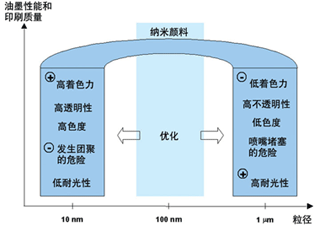As recently reported, the "100 nm" pigment (d50) achieves the best balance of dye behavior and lightfastness requirements (Figure 2). If the d50 value is too high, the printing reliability will be impaired by the large particle pigments or agglomerates blocking the print head channels and nozzles. Under the foam jet print head, a short temperature rise to 500°C may occur. This is a quasi-complete process: heating of the colorant in one or more solvents (ink auxiliaries) may result in unwanted particles or re-agglomeration. Larger particles also reduce the transparency and color of inkjet printing.
On the other hand, very fine particles tend to re-agglomerate due to the larger specific surface, resulting in enhanced interaction between particles. In turn, the viscosity increases, reducing storage stability. It should be pointed out that even the high lightfastness of pigments varies: Some pigments are very lightfast, others fade as fast as dyes. However, lightfastness generally tends to decrease when the particles are much smaller than 50 nanometers.
purity
Another parameter for the colorant to meet the quality of inkjet application is high purity, and the residual organic or inorganic impurity content should be controlled within a few ppm. It is well-known that chloride ions accelerate corrosion of the printhead; some cations form insoluble mixtures with many dispersant molecules, which reduces the stability of the pigment formulation. Ink containing similar impurity ions may exhibit flocculation or precipitation during storage, resulting in clogged printhead nozzles. In order to ensure the quality of the ink used in jet printing, special grade pigments are under development and their salt content and impurities are very low. Only pigments that have been screened and have good compatibility with ink jet systems can be adopted. Cubic particles are best suited for inkjet inks.
Surface charge and polarity
Surface charge and polarity mainly depend on the molecular structure and chemical properties of the pigment. The polarities of organic pigments may be non-polar (hydrophobic), highly polar (hydrophilic) or in-between. The polarity of the pigment can be calculated from the contact angles (tension measurements) of different solvents. The polarity of the pigment is an important factor in the dispersion process. In order to ensure good wetting properties of the pigment, it is necessary to find out the correct combination of pigment and dispersion medium. Figure 3 shows an example of the formation of two samples of PY 180 and dispersion media with completely different polarities. Type A is extremely hydrophobic and can float on water, while Type B is hydrophilic and has good wettability in water-based systems. In addition, Class A is more suitable for better wetting in hydrophobic solvent media. Therefore, the polarity of the pigments needs to be optimized for different applications and these requirements must be met during pigment processing.

Figure 3: Two surface features of PY 180 (hydrophobic Type A and hydrophilic Type B)
(to be continued)
A training desk is a table designed specifically for activities such as training and meetings. It has characteristics such as durability and ease of movement, which can meet the needs of different groups of people. Training desks can be classified into various categories based on their materials, structure, and other aspects. Below will be a brief introduction to the classification of training desks.
1. Material classification
The materials of the Training Chair mainly include wooden boards, PVC boards, etc. Training desks made of wood usually have strong stability and durability, making them suitable for long-term meetings or training activities. The training table made of PVC board has certain safety performance and is generally more lightweight.
2. Structural classification
The structure of training chairs mainly includes single tables, combination tables, etc. A single chair is the most common training table, and each training table is independent and can be adjusted as needed. Combination refers to the combination of multiple seats together, usually in the form of geometric shapes or rows, suitable for use in large training venues. A stackable table is a training table that can be folded and placed together, saving space and facilitating storage and handling.
Training Table,Tea Table,Coffee Table,Visitor Table
Foshan Shengshi Zhihui Technology Co., Ltd. , https://www.sshotelfurniture.com